In this article, I want to deeply dive into Sequencer, which plays an important role in the Ethereum L2 rollup.
TL;DR
- Shared Sequencer (SS) is the 'Winner Takes All' market because it has strong network effects.
- Rollup has emerged to improve the scalability of Ethereum. It has grown significantly over the past year.
- There are issues with the current rollup. The sequencer, which is currently centralized, is responsible for sending transactions processed by rollup.
- The advantages of using shared sequencers are: 1. simplicity and low cost, 2. strong economic security and decentralization, 3. fast transactions, and 4. cross-chain atomicity.
Growth of Rollups
Ethereum's Vitalik stated in A rollup-centric Ethereum roadmap in October 2020 and The Three Transitions in June 2023 that Ethereum will be primarily active on rollup.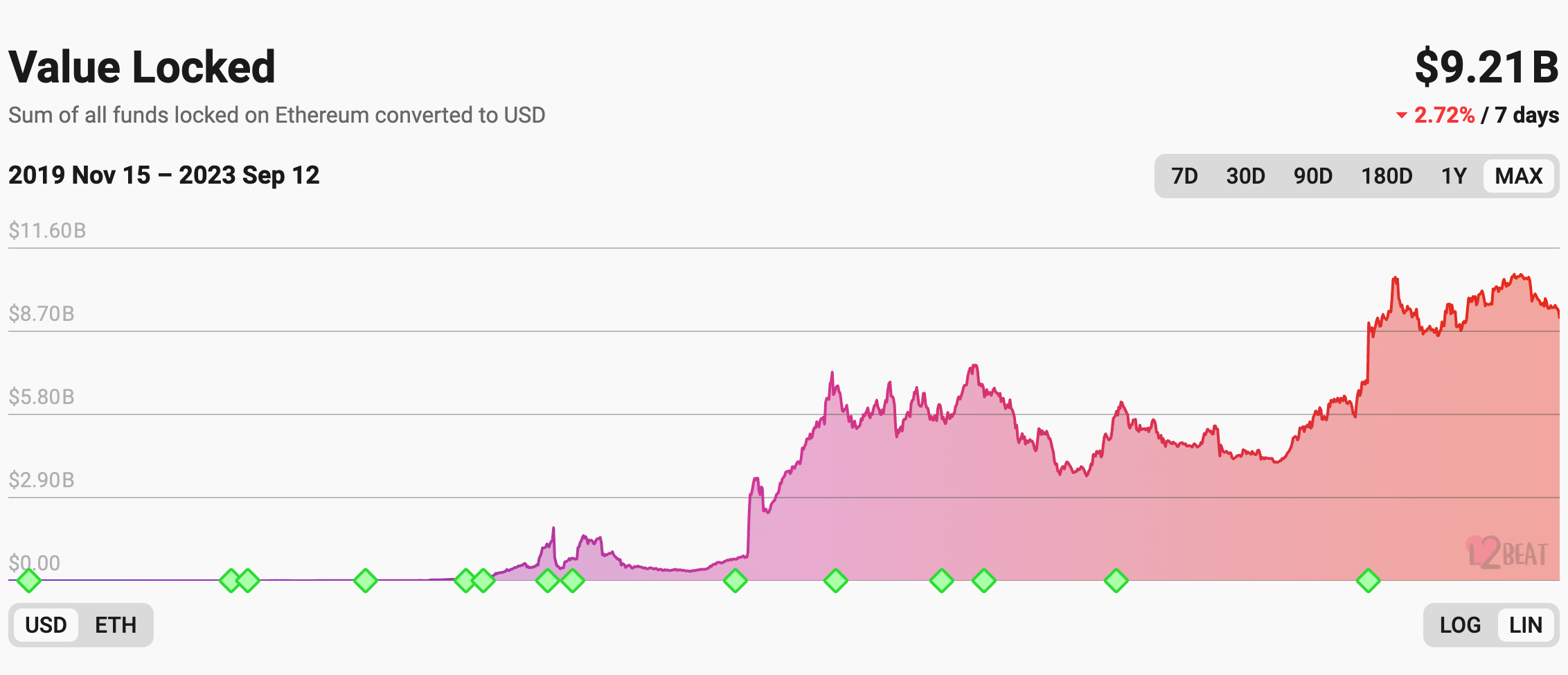
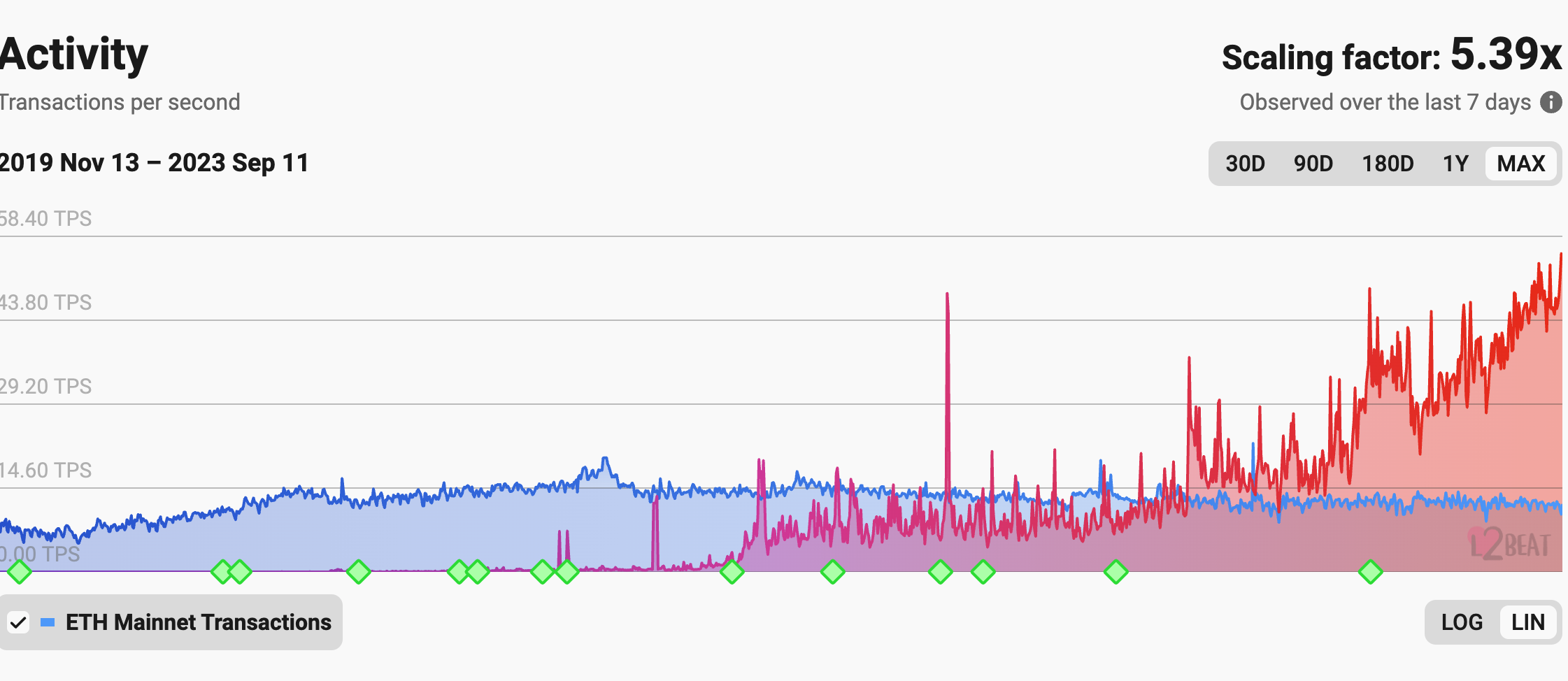
Source: L2 Beat
The rollup ecosystem has increased over the past year, as shown in the chart above.
We will look deeper at the sequencer, a key player in rollup's development.
How Rollup Works
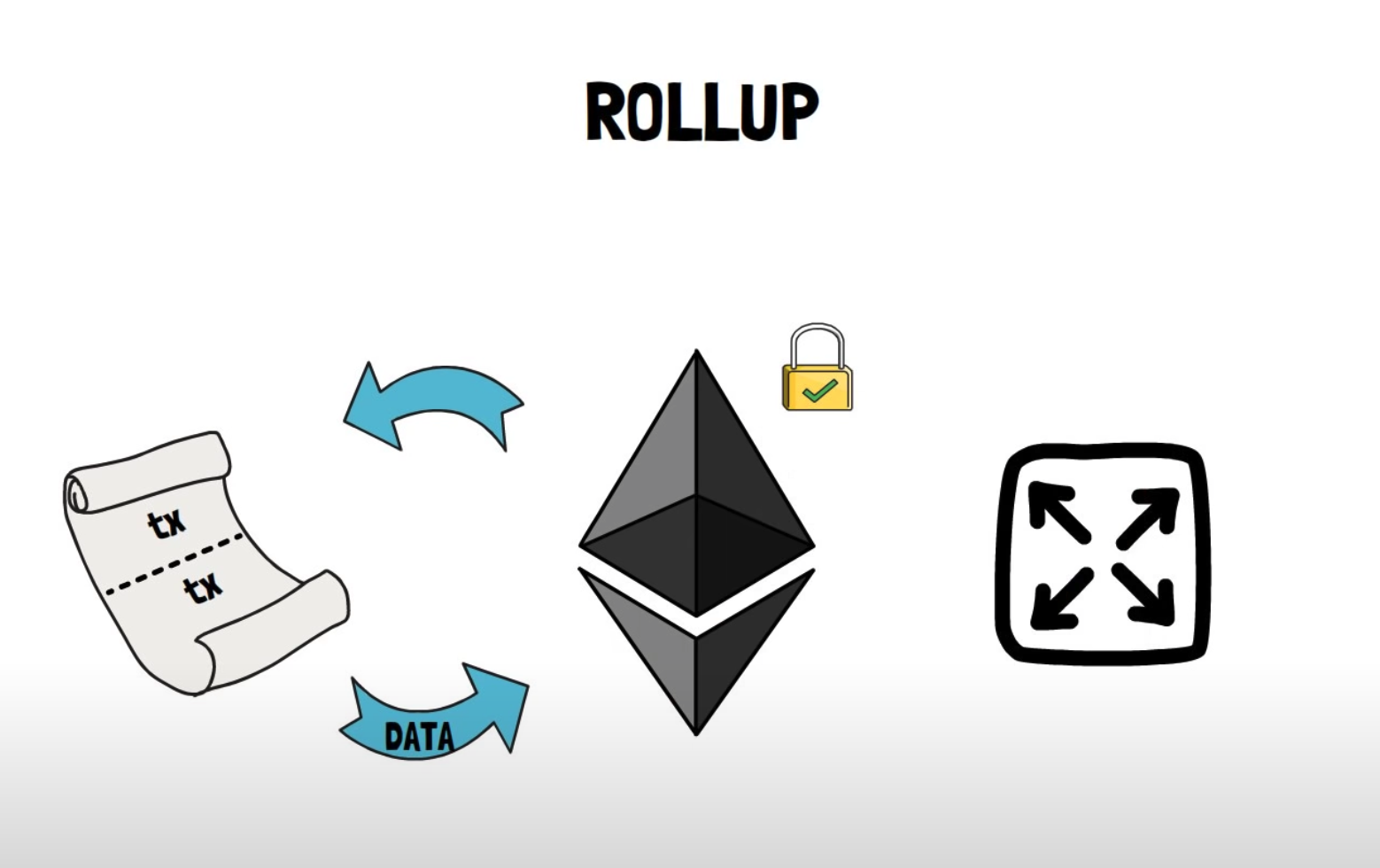
Source: ROLLUPS - The Ultimate Ethereum Scaling Strategy? Arbitrum & Optimism Explained
First, let us explain the premise of how rollups work.
As Ethereum grew as an ecosystem and the number of applications and users increased, its scalability reached its limits.
Therefore, rollup is a mechanism that has emerged to improve scalability.
This mechanism improves scalability by processing transactions together off-chain and sending them to L1 in batches.
(Execution only is called Smart Contract Rollup, while execution and settlement are called Sovereign Rollup. See this article for more details).
What is Sequencer?
The sequencer is responsible for sending batches of transactions processed off-chain.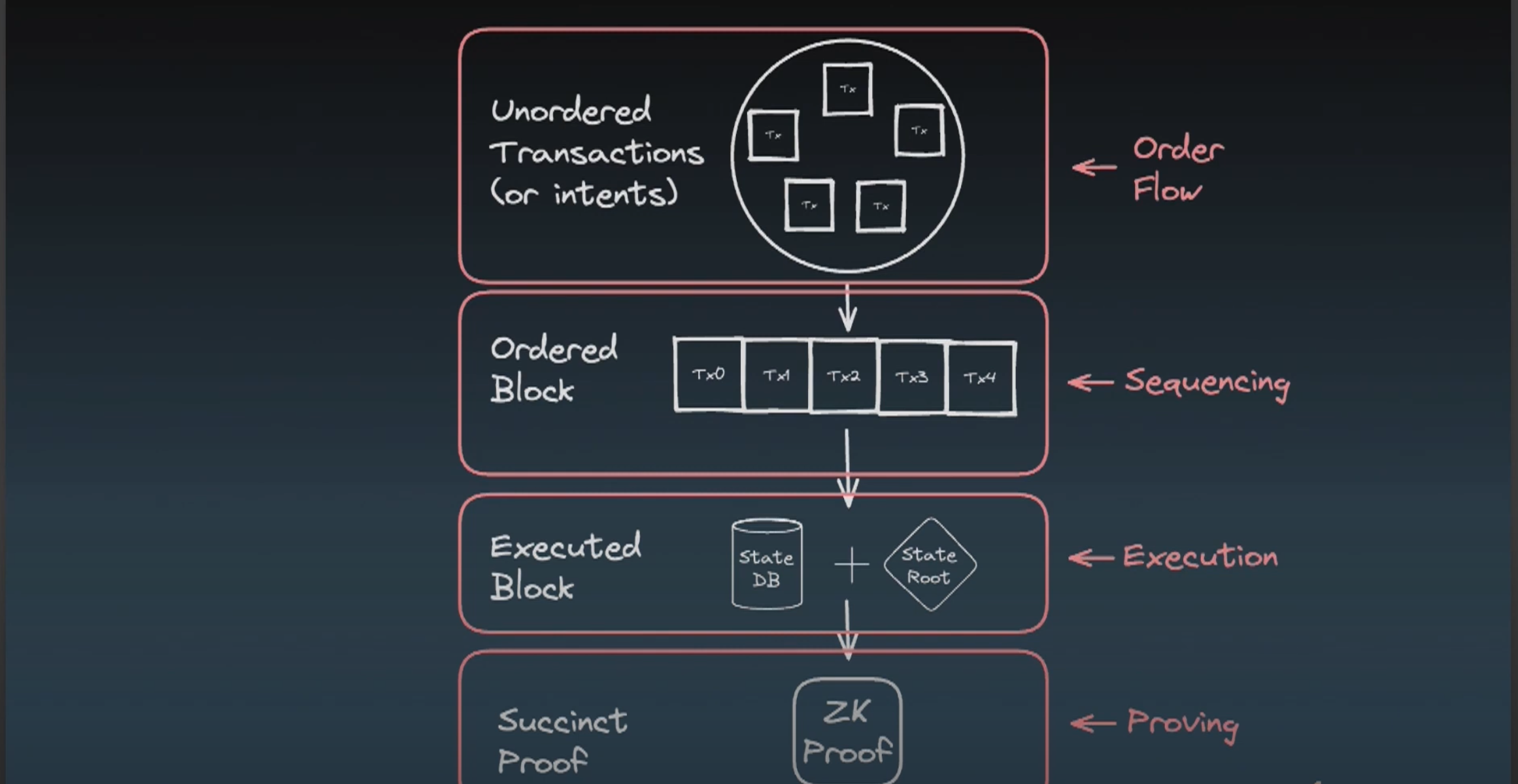
Source: Astria’s Vision for the Endgame - Josh Bowen
Currently, in most rollups, the sequencer is operated in a centralized manner.
Given the current priorities of each rollup project, this is an efficient decision, but it poses challenges in terms of real-time liveness and censorship resistance.
Sequencer Classification
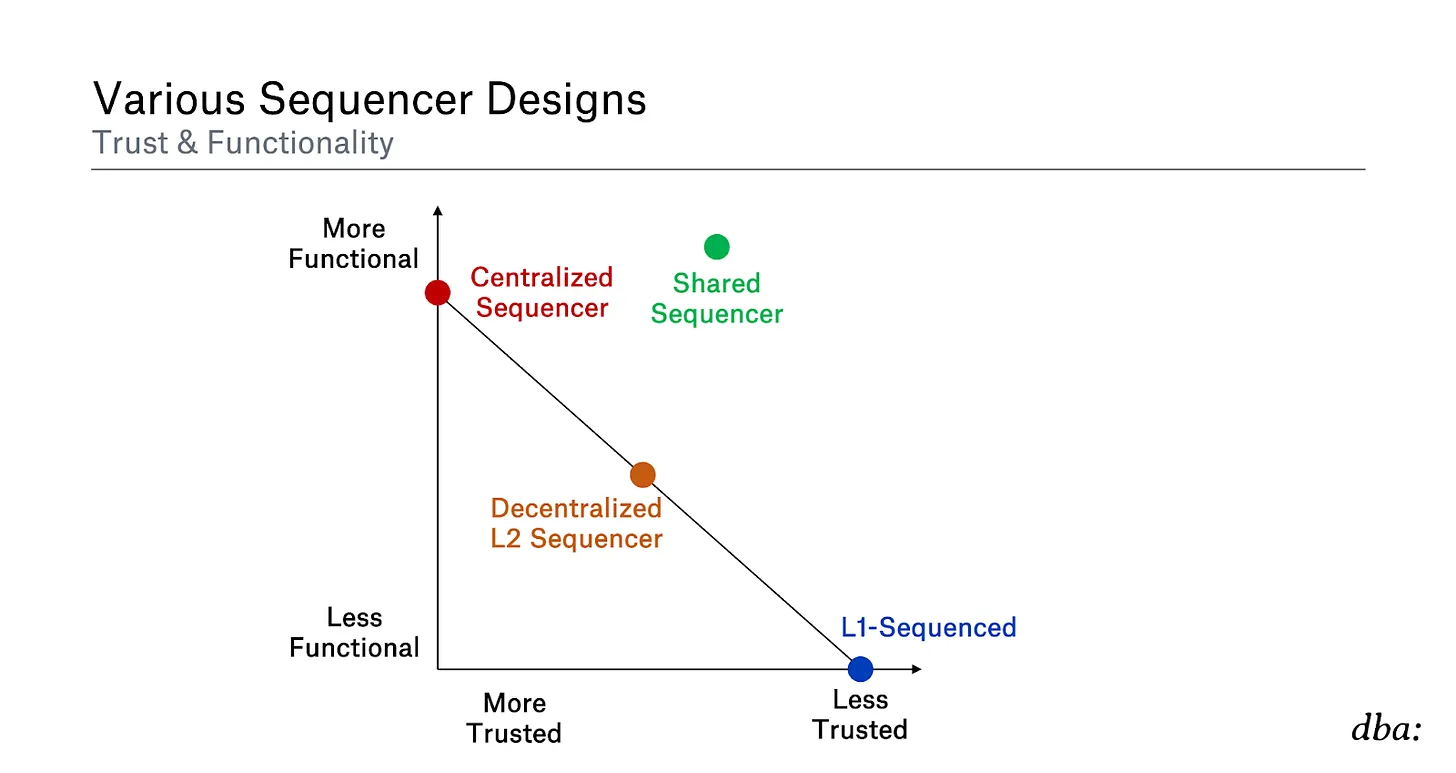
Source: Rollups Aren’t Real
To quote Jon's classification of dba, sequencers can be categorized as follows.
- Centralized Sequencer - Any feature can be easily implemented if you have complete control over the system. However, guarantees regarding the strength of pre-confirmation may not be optimal, and forced termination may not be desirable.
- Distributed L2 Sequencer - A distributed set of sequencers with a certain amount of stakes should increase the robustness of rollup compared to a centralized sequencer. However, there may be tradeoffs, such as latency, depending on how they are implemented. (e.g., if many L2 nodes need to vote before confirming a block of rollups)
- L1 Sequenced - Maximum decentralization, censorship resistance, liveness, etc. can be achieved. However, it lacks functionality (fast pre-confirmation, limited data throughput, etc.)
- Shared Sequencer - Access to distributed sequencing functionality, benefits of sharing it with others (some degree of atomicity), and no need to bootstrap your own sequencing set. However, the period waiting for L1 finality is a weaker commitment guarantee than with L1 sequencers. SS can also provide more robust security than if each rollup builds a separate distributed Sequencer.
Criticisms of Centralized Sequencer
Currently, each rollup project operates its single sequencer.
Because it is operated in a centralized manner, it has been criticized for the following points.
- A single point of failure
- Lack of censorship resistance
- Lack of interoperability
- Possibility of MEV monopoly
Decentralizing the sequencer is difficult, as is having the L1 blockchain collect its validator set. In addition, decentralization of sequencers is currently on the back burner due to other high-priority issues.
Improvement of the Centralized Sequencer
Here are some ways to improve the centralized sequencer.
Proof of Authority (PoA)
A simple way to improve a single sequencer is to grant permission to a few geographically distributed sequencers. You may be familiar with this in enterprise blockchains.
Several socially trusted companies are selected to serve as sequencers in turn.
A certain amount of money can be pledged as collateral to encourage honest behavior.
It is an improvement over the single centralized sequencer but still imperfect.
Sequencer Auction (MEV auction)

Source: MEV Auction: Auctioning transaction ordering rights as a solution to Miner Extractable Value
It is also possible to conduct MEV auctions directly via smart contracts for the right to perform sequencer. Anyone can participate in the bidding, and the auction contract gives the right to sequencer to the highest bidder. The auction can be done per block or period.
There should also be a mechanism to pay a certain deposit amount to ensure the winning bidder acts in good faith.
If the auction mechanism is not built in at the protocol level, some off-chain auctions, such as Ethereum's MEV-Boost (PBS), will occur.
Permissionless PoS for leader selection
The sequencer is selected by a mechanism similar to L1's Proof of Stake (PoS).
By staking L2 native tokens, sequencers can participate in Permissionless PoS. The staking can be established at the L1 baselayer through a smart contract or directly within rollup.
As with L1, the sequencer's rights are randomly awarded based on stake volume.
Sequencers who are dishonest or malicious will be subject to penalties such as thrashing.
Permissionless PoS for Leader Election & L2 Consensus
Sequencer election and local consensus in L2 can be held before finality in L1 if necessary. This is precisely how StarkNet plans to use their STRK token.
L2 PoS consensus can temporarily obtain strong pre-confirmation by local consensus in L2 before L1 finality. Getting this pre-confirmation also allows for faster transactions in L2.
Is Consensus L1 or L2?
As we have discussed, L2 can implement its local consensus or not.
L2 local consensus is "the signing of the block by the L2 Validator before sending the block to L1 for final consensus."
For example, a smart contract in L1 could recognize, based on its rules for
- PoS for sequencer election and consensus: only blocks signed by L2 local consensus can be accepted.
- PoS for sequencer election: the sequencer is allowed to submit blocks at this point is this person
Whether the consensus is L1 or L2, the value of L2 is assigned to rollup tokens.
Even if rollup tokens are used to elect a sequencer without consensus, the tokens will still have value.
Advantages and Disadvantages of Consensus in L2
As we have discussed, the advantage of having a consensus in L2 is that it provides a fast user experience by providing prior confirmation and soft commitment.
Disadvantages include inefficiency in obtaining consensus itself and weakening censorship resistance.
L1 Sequenced - Based Rollup
The proposals introduced so far somehow give the sequencer the privilege of creating rollup blocks. This section presents a proposal that does not give the sequencer any privileges.
Justin Drake of Ethereum has proposed the idea of a Based Rollup.
This, in a nutshell, allows the L1 proposer to include the most valuable rollup block in his L1 block via the builder. This simple mechanism allows for the decentralization of L1 and liveness.
It is being considered to process L2 transactions in the L1 mempool or a new mem pool for each L2 rollup.
Disadvantages include reduced sequencer flexibility and a slower L2 user experience since no pre-confirmation is obtained. It would also limit the design space for MEVs.
Benefits of Shared Sequencer
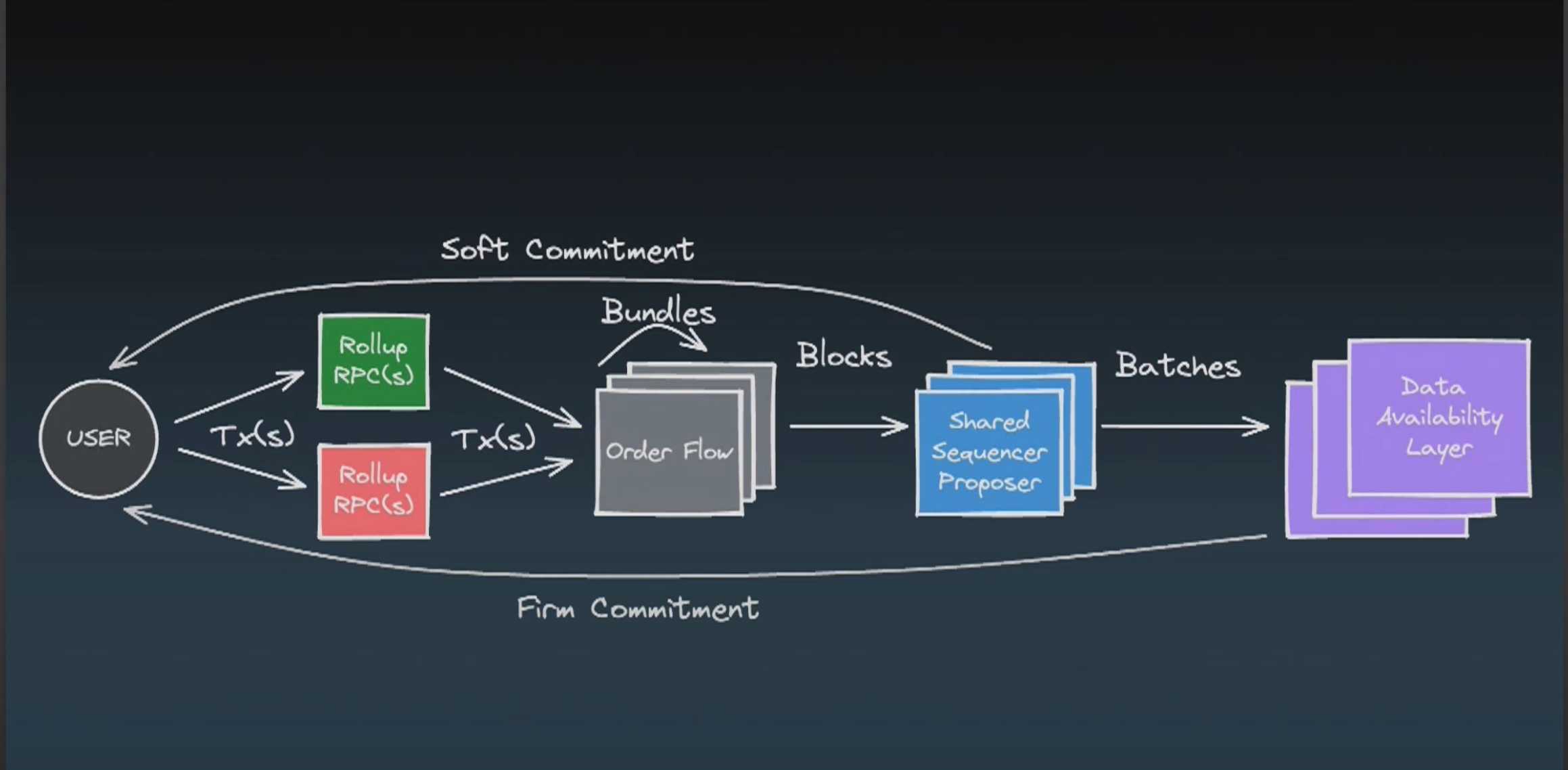
Source: Astria's Vision for the Endgame - Josh Bowen
SS is a mechanism for sequencers to be shared among rollups.
From a modular blockchain perspective, it is also a sequencer Layer.
According to dba's Jon's blog Rollups Aren't Real, SS has the following advantages.
- Easy and low cost
- Each rollup has its own sequencer set, which can be expensive and time-consuming; with SS, you can plug in and start using it right away, without having to recruit and manage sequencer Sets.
- Strong Security and Decentralization
- Collecting Sequencers for each rollup is not secure on a small scale, but SS provides stronger, more economical security and censorship resistance.
- High-speed transactions
- The centralized Single sequencer is also fast in transactions. However, achieving high transaction speed through pre-confirmation while maintaining decentralization is advantageous.
- Cross-rollup atomicity
- It is possible to execute transactions on two different rollups simultaneously. This also solves the problem of liquidity fragmentation that occurs when assuming a modular blockchain. (There will also be the issue of cross-chain MEVs.)
Let's look at some significant projects and see how they work.
Espresso
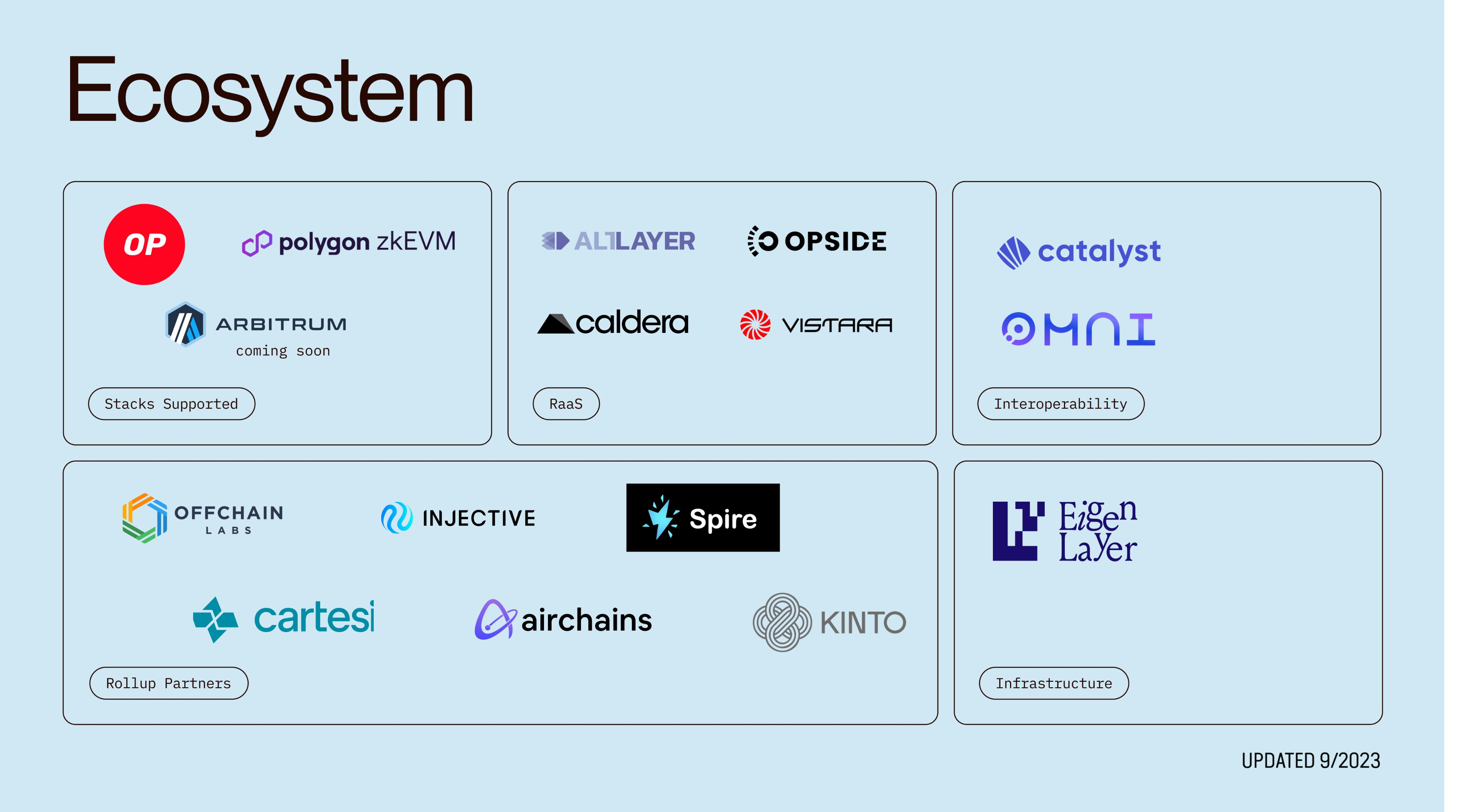
Source: Espresso's Tweet at the time of the partnership announcement
Espresso is the most developed and partnered of the SS projects. Most recently, it has also announced a partnership with Offchain Labs, the developer of Arbitrum.
In March 2022, they raised $32M from lead investors such as Greylock Partners and Electric Capital, with Sequoia, Polychain, Coinbase Ventures, and other prominent investors also participating. At the time, it appeared to be an L1 blockchain project focused on Privacy.
Espresso CEO Ben Fisch is also an associate professor at Yale University. Before that, he was a PhD student at Stanford in the applied cryptography research group. Many other team members also have a background in cryptography researcher and seem technically sound.
In November 2022, they announced SS on their blog, Decentralizing Rollups: Announcing the Espresso Sequencer. (On the same day, they also announced the release of Testnet called Americano. Now the third Testnet is Cortada).
The following diagram illustrates how Espresso Sequencer works.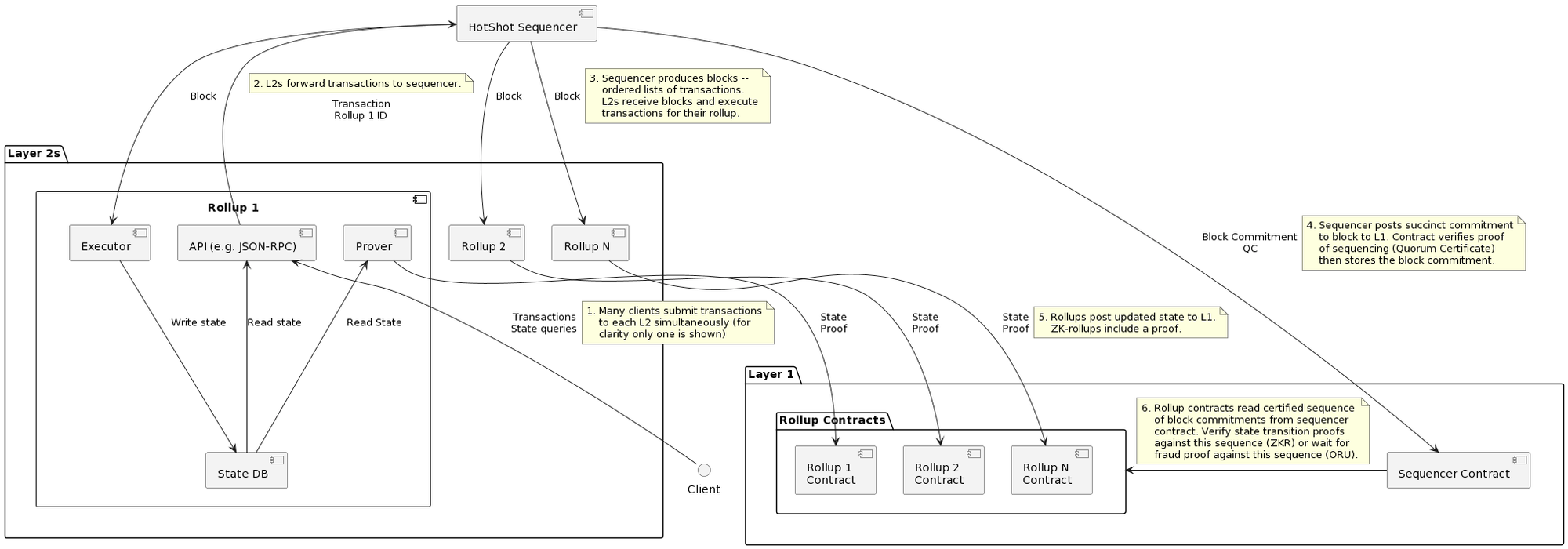
Source: Espresso
This diagram shows the flow of information through the entire system, starting from the transaction submission, through the Client to the various integrated rollups, and finally to being authenticated and checkpointed at Layer 1.
- Client submits transactions to API in rollup
- L2 forwards transactions to sequencer
- The sequencer builds a block - determines the order of the transaction list L2s receive the block and execute the transaction in rollup.
- The sequencer posts a succinct commitment to block and L1; the contract verifies sequencing order. Then it stores the block commitment.
- Rollup posts updated state to L1 (zk-rollups include proof)
- Rollup Contracts reads the authenticated sequence of block commitments from the sequencer. Verify state transition proofs for this sequence (ZKR) or wait for fraud proofs (ORU).
HotShot Consensus
Espresso uses a proprietary consensus algorithm called HotShot.
Its advantages are censorship resistance and prevention of oligopoly in block construction.
HotShot is also considering using EigenLayer for security due to the requirement to have security comparable to Ethereum and to align the timing of finality.
Tiramisu - The Three-Layered Espresso DA
They are also building their own DA layer called Tiramisu.
Most rollups use Ethereum and other high-cost DA layers, but there is a need for a low-cost, more scalable DA.
It consists of three layers: Cocoa (CDN), Marscapone (small DA committee), and Savoiardi (infrastructure).
Cocoa utilizes Content Delivery Network (CDN) for higher speed and to provide higher performance. Americano, their test network, delivers data at approximately 2.5 MB/s for a scale of 100 nodes.
(Depending on the performance in production, 2.5 MB/s may be competitive with DA layers such as Celestia.)
Future Espresso - PBS
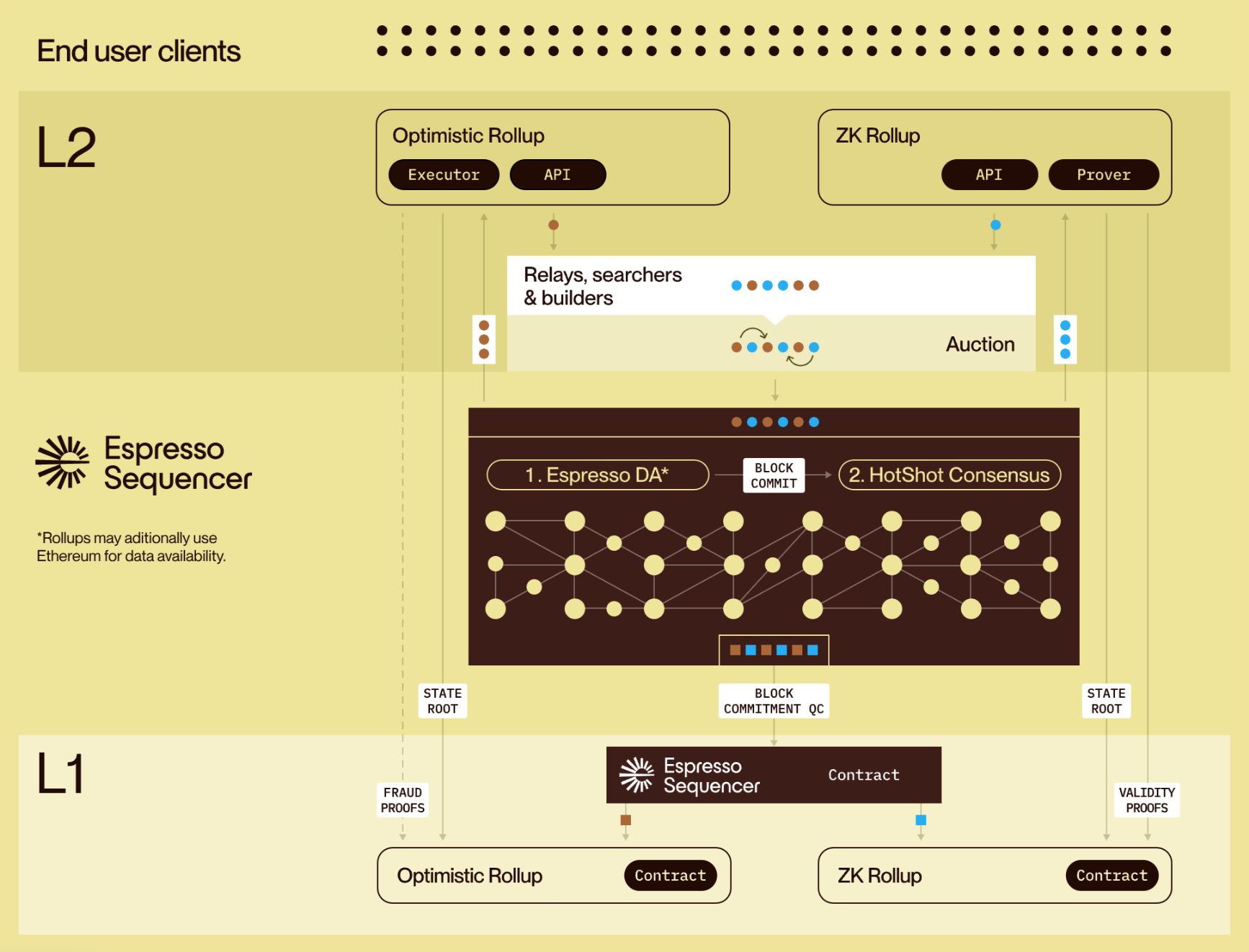
Source: Espresso Systems
Looking at Espresso's future vision, it is envisioned that the block generation process will include similar actors to Ethereum MEV value chain, such as searcher, builder, and relay.
Astria
Astria is a project of SS with EVM on Celestia.
CEO Josh Bowen was a Developer on Celestia before Astria.
The company has raised $5.5M in seed funding. The round was led by Maven 11, with participation from 1kx, Delphi Digital, Lemniscap, Figment Capital, Nurikabe, Anagram, Robot Ventures and Breed VC.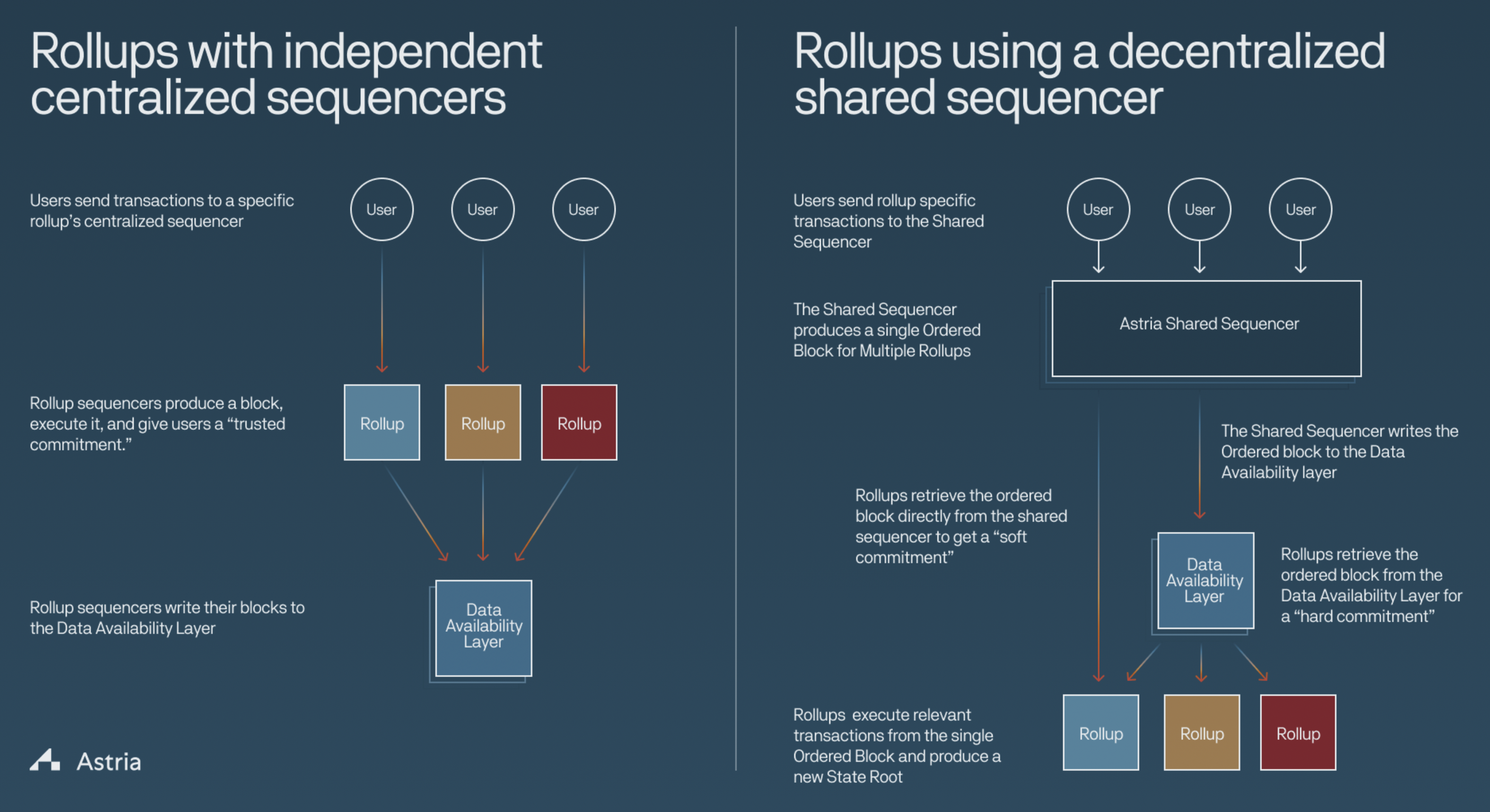
Source: Introducing Astria: The Shared Sequencer Network
Since the CEO is from Celestia, he insists on the importance of providing Astria EVMs and Sovereign Rollups using Celestia as a DA layer.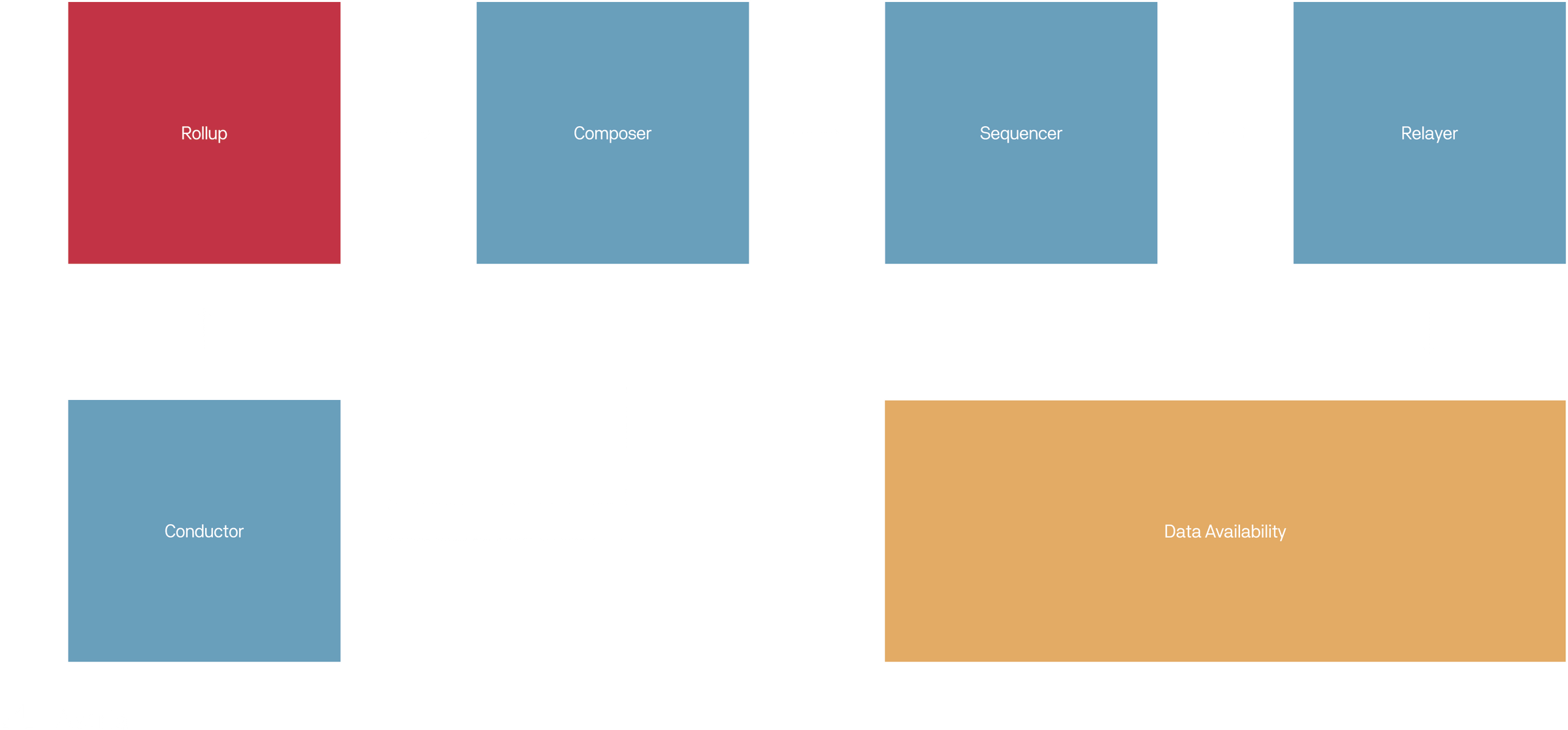
Source: Introducing the Astria Development Cluster
The Development Cluster (Development Environment) was offered in August 2023.
This mechanism shows that there is also an actor called Composer, which plays a role similar to that of a searcher/block builder, and that it is envisioned to be similar to the existing Ethereum L1 block generation value chain.
Tradeoffs of the Shared Sequencer Set
Sequencer plays an equivalent role to the Validator in the L1 blockchain; let's look at the characteristics of the Validator Set in each of the L1 blockchains.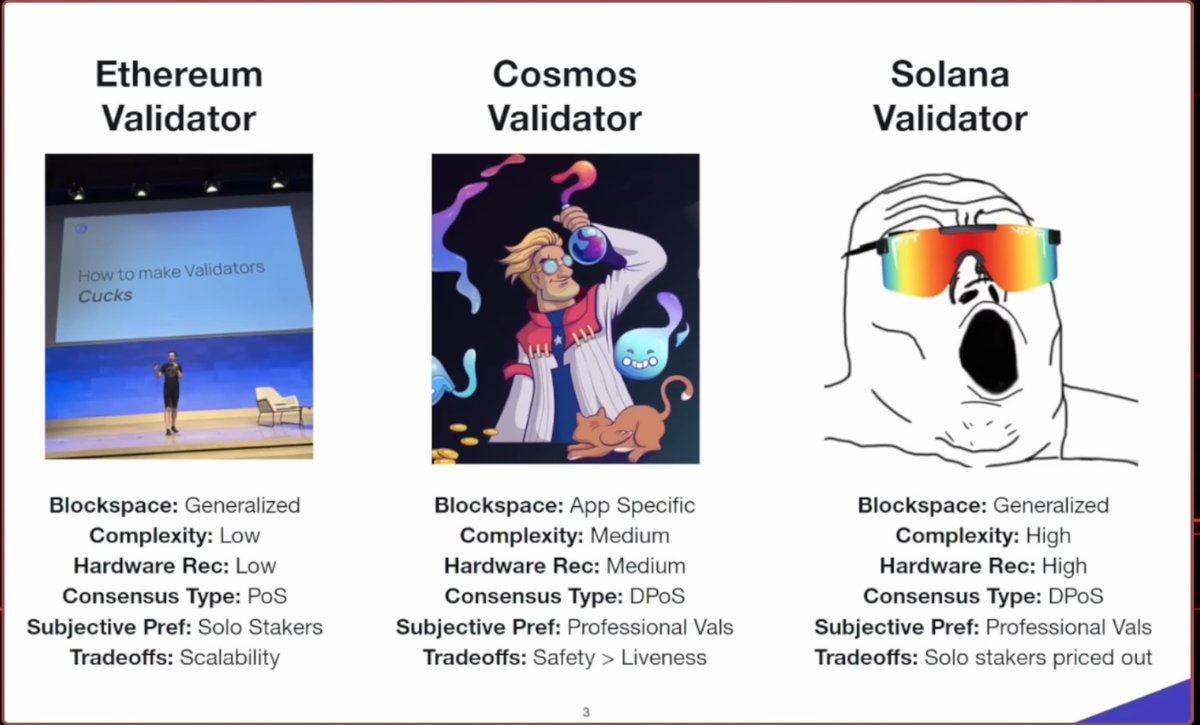
Source: Blockchain Trilemma
As can be seen in the diagram above, Ethereum wants to allow individuals to operate their own Validators. they want to promote decentralization.
Therefore, we can keep complexity and hardware requirements low. The current number of Validators is 792,862. Cosmos is somewhere in between. (Number of Validators Solana 1,893, CosmosHub 180)
For example, you may need fast finality to provide a great UX in building an SS. In such cases, performance can be improved by capping the number of sequencers and sacrificing decentralization and censorship resistance.
(All Validator numbers are as of September 13, 2023)
Shared Sequencer Revenue and Cost
SS revenues and costs are the same as for the L1 validator.
Revenue
Revenues are earned from both users and a fixed fee for rollup. This fee can be a percentage of the MEV, the value of the cross-chain, the cost of gas, or a fee for Interoperability.
The cost paid to SS must be less than the value of connecting to SS; Rollup would have to be better positioned to use SS to develop.
SS is a network effect area, and the more rollups, the more users, the more valuable SS becomes. This should make the ability to collect fees stronger.
Also, the more rollups that participate, the more opportunities there will be to extract cross-domain MEVs.
Cost
Since SS is an area where network effects can be practical, some projects may adopt a strategy of expanding market share without regard to cost in the early stages.
It is possible to increase market share by bearing the cost of posting to the DA layer and the cost of interacting with apps on rollup. Another possible way, unique crypto, would be for rollup to pay the fees to DA in native tokens.
As for the DA layer, costs can be reduced by selecting a lower-cost DA layer.
Incentives to participate in Shared Sequencer
Currently, each rollup operates its sequencer and generates revenue through commissions, MEV, etc. This is called an Isolated sequencer.
Most of the rollups have announced that they will decentralize their operations in the future. However, when participating in SS, it will be essential to see how the revenue and cost will change compared to the current situation.
- Isolated sequencer revenue: MEV for each domain
- SS revenue: MEV of each domain + cross-domain MEV
Will the participation of many rollups in SS result in a more significant sum of revenues, thus greater revenues than if the rollups were to do it alone?
It depends on how much profit will be filled by the upside of cross-domain MEVs and other revenues and the reduction of DA costs by pre-combining transactions.
Winner Takes All - Strong Network Effects
SS is an area where network effects are strong.
Network effect means "the more people use a service/product, the more the utility of that service/product increases."
The more rollups that use SS, the more value SS provides.
- Liquidity: Liquidity can be increased by increasing the number of transactions that can be consolidated.
- MEV: Cross-domain MEV (MEV between rollups) opportunities increase.
- Incentives for new rollups: Given the benefits of the previous two points, the disadvantages of not using SS are greater, so new late-start rollups will increasingly choose SS with a larger market share.
Finally.
We have introduced the fundamental aspects of SS.
SS will change as mechanisms such as PBS are incorporated in the generation of rollup blocks, SUAVE by Flashbots, and Intent, a new concept of transaction, will emerge.
In the area of SS, network effects are likely to be strong, and there is a possibility that those who expand their scale quickly will dominate the market.
Tané is active in investing in the Crypto infrastructure space. Interested parties can contact us here.
Special thanks to Yu Kimura, Takeshi Ohishi for reviewing this post.
References:
The Shared Sequencer
Why enshrine Proposer-Builder Separation? A viable path to ePBS
https://twitter.com/Jskybowen/status/1643719277277749250
Espresso Systems Launches to Public Amid a $32M Raise
Decentralizing Rollups: Announcing the Espresso Sequencer
Modular Blockchain Astria Raises $5.5M for Shared Sequencer Network
Earn rewards while securing Ethereum
Network Performance Report: July 2023
Disclaimer: This post is for general information purposes only. It does not constitute investment advice or a recommendation or solicitation to buy or sell any investment. It should not be used to evaluate the merits of making any investment decision. It should not be relied upon for accounting, legal or tax advice or investment recommendations. This post reflects the current opinions of the authors. It is not made on behalf of Tané or its affiliates and does not necessarily reflect the opinions of Tané, its affiliates or individuals associated with Tané. The opinions reflected herein are subject to change without being updated.